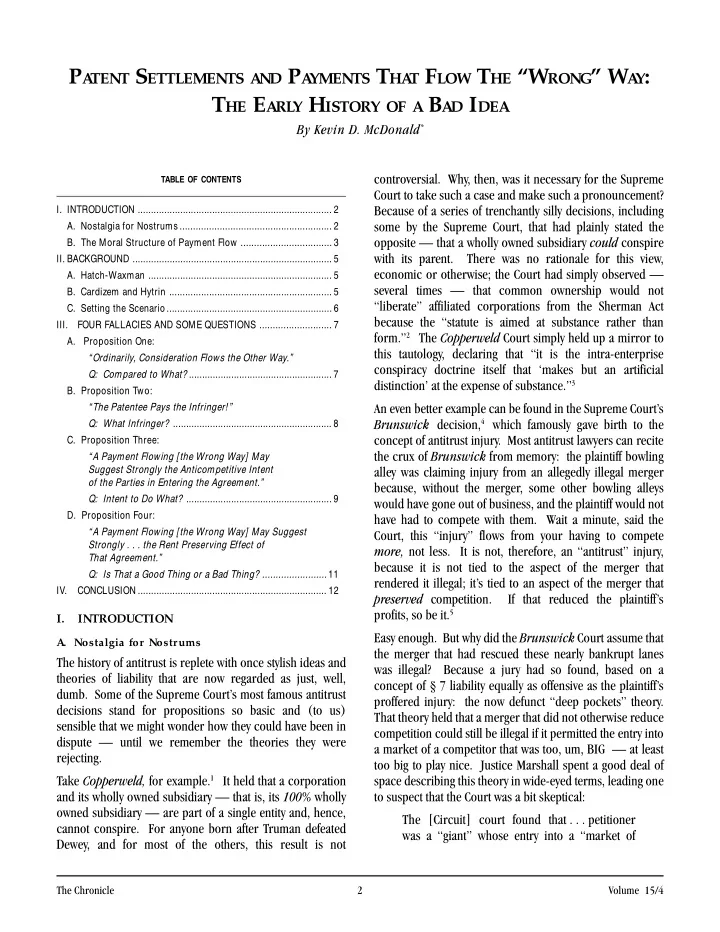

P A T S ETTLEMEN TS A D P A TS T HA T F LOW T HE “W RON G ” W A Y : TEN N YMEN T HE E A Y H ISTORY OF A B A D I DEA RL By Kevin D. McDonald * TABLE OF CONTENTS controversial. Why, then, was it necessary for the Supreme Court to take such a case and make such a pronouncement? Because of a series of trenchantly silly decisions, including I. INTRODUCTION ......................................................................... 2 some by the Supreme Court, that had plainly stated the A. Nostalgia for Nostrums ......................................................... 2 opposite — that a wholly owned subsidiary could conspire B. The Moral Structure of Payment Flow .................................. 3 with its parent. There was no rationale for this view, II. BACKGROUND ........................................................................... 5 economic or otherwise; the Court had simply observed — A. Hatch-Waxman ..................................................................... 5 several times — that common ownership would not B. Cardizem and Hytrin ............................................................. 5 “liberate” affiliated corporations from the Sherman Act C. Setting the Scenario .............................................................. 6 because the “statute is aimed at substance rather than III. FOUR FALLACIES AND SOME QUESTIONS ........................... 7 form.” 2 The Copperweld Court simply held up a mirror to A. Proposition One: this tautology, declaring that “it is the intra-enterprise “Ordinarily, Consideration Flows the Other Way.” conspiracy doctrine itself that ‘makes but an artificial Q: Compared to What? ...................................................... 7 distinction’ at the expense of substance.” 3 B. Proposition Two: An even better example can be found in the Supreme Court’s “The Patentee Pays the Infringer!” Brunswick decision, 4 which famously gave birth to the Q: What Infringer? ............................................................ 8 concept of antitrust injury. Most antitrust lawyers can recite C. Proposition Three: the crux of Brunswick from memory: the plaintiff bowling “A Payment Flowing [the Wrong Way] May Suggest Strongly the Anticompetitive Intent alley was claiming injury from an allegedly illegal merger of the Parties in Entering the Agreement.” because, without the merger, some other bowling alleys Q: Intent to Do What? ....................................................... 9 would have gone out of business, and the plaintiff would not D. Proposition Four: have had to compete with them. Wait a minute, said the “A Payment Flowing [the Wrong Way] May Suggest Court, this “injury” flows from your having to compete Strongly . . . the Rent Preserving Effect of more, not less. It is not, therefore, an “antitrust” injury, That Agreement.” because it is not tied to the aspect of the merger that Q: Is That a Good Thing or a Bad Thing? ........................ 11 rendered it illegal; it’s tied to an aspect of the merger that IV. CONCLUSION ....................................................................... 12 preserved competition. If that reduced the plaintiff’s profits, so be it. 5 I. INTRODUCTION Easy enough. But why did the Brunswick Court assume that A. Nostalgia for Nostrums the merger that had rescued these nearly bankrupt lanes The history of antitrust is replete with once stylish ideas and was illegal? Because a jury had so found, based on a theories of liability that are now regarded as just, well, concept of § 7 liability equally as offensive as the plaintiff’s dumb. Some of the Supreme Court’s most famous antitrust proffered injury: the now defunct “deep pockets” theory. decisions stand for propositions so basic and (to us) That theory held that a merger that did not otherwise reduce sensible that we might wonder how they could have been in competition could still be illegal if it permitted the entry into dispute — until we remember the theories they were a market of a competitor that was too, um, BIG — at least rejecting. too big to play nice. Justice Marshall spent a good deal of Take Copperweld, for example. 1 It held that a corporation space describing this theory in wide-eyed terms, leading one and its wholly owned subsidiary — that is, its 100% wholly to suspect that the Court was a bit skeptical: owned subsidiary — are part of a single entity and, hence, The [Circuit] court found that . . . petitioner cannot conspire. For anyone born after Truman defeated was a “giant” whose entry into a “market of Dewey, and for most of the others, this result is not The Chronicle 2 Volume 15/4
Recommend
More recommend